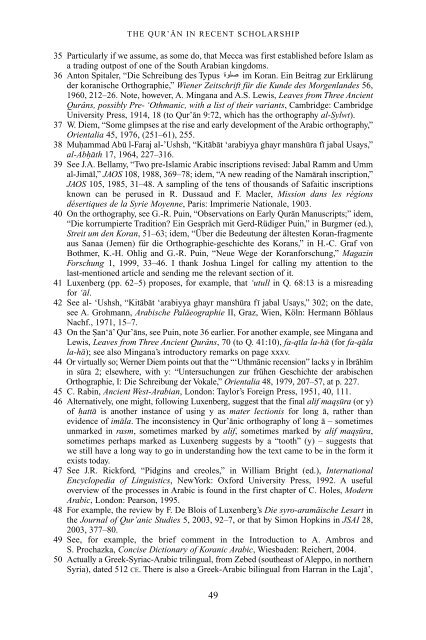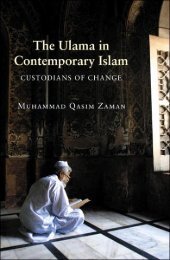The Qur'an in its historical context (pdf - Islam and Christian-Muslim ...
The Qur'an in its historical context (pdf - Islam and Christian-Muslim ...
The Qur'an in its historical context (pdf - Islam and Christian-Muslim ...
You also want an ePaper? Increase the reach of your titles
YUMPU automatically turns print PDFs into web optimized ePapers that Google loves.
THE QUR’AN IN RECENT SCHOLARSHIP<br />
35 Particularly if we assume, as some do, that Mecca was first established before <strong>Islam</strong> as<br />
a trad<strong>in</strong>g outpost of one of the South Arabian k<strong>in</strong>gdoms.<br />
36 Anton Spitaler, “Die Schreibung des Typus im Koran. E<strong>in</strong> Beitrag zur Erklärung<br />
der koranische Orthographie,” Wiener Ze<strong>its</strong>chrift für die Kunde des Morgenl<strong>and</strong>es 56,<br />
1960, 212–26. Note, however, A. M<strong>in</strong>gana <strong>and</strong> A.S. Lewis, Leaves from Three Ancient<br />
Qurâns, possibly Pre- ‘Othmanic, with a list of their variants, Cambridge: Cambridge<br />
University Press, 1914, 18 (to Qur’an 9:72, which has the orthography al-Sylwt).<br />
37 W. Diem, “Some glimpses at the rise <strong>and</strong> early development of the Arabic orthography,”<br />
Orientalia 45, 1976, (251–61), 255.<br />
38 Muhammad Abu l-Faraj al-’Ushsh, “Kitabat ‘arabiyya ghayr manshura fi jabal Usays,”<br />
al-Abhath 17, 1964, 227–316.<br />
39 See J.A. Bellamy, “Two pre-<strong>Islam</strong>ic Arabic <strong>in</strong>scriptions revised: Jabal Ramm <strong>and</strong> Umm<br />
al-Jimal,” JAOS 108, 1988, 369–78; idem, “A new read<strong>in</strong>g of the Namarah <strong>in</strong>scription,”<br />
JAOS 105, 1985, 31–48. A sampl<strong>in</strong>g of the tens of thous<strong>and</strong>s of Safaitic <strong>in</strong>scriptions<br />
known can be perused <strong>in</strong> R. Dussaud <strong>and</strong> F. Macler, Mission dans les régions<br />
désertiques de la Syrie Moyenne, Paris: Imprimerie Nationale, 1903.<br />
40 On the orthography, see G.-R. Pu<strong>in</strong>, “Observations on Early Quran Manuscripts;” idem,<br />
“Die korrumpierte Tradition? E<strong>in</strong> Gespräch mit Gerd-Rüdiger Pu<strong>in</strong>,” <strong>in</strong> Burgmer (ed.),<br />
Streit um den Koran, 51–63; idem, “Über die Bedeutung der ältesten Koran-fragmente<br />
aus Sanaa (Jemen) für die Orthographie-geschichte des Korans,” <strong>in</strong> H.-C. Graf von<br />
Bothmer, K.-H. Ohlig <strong>and</strong> G.-R. Pu<strong>in</strong>, “Neue Wege der Koranforschung,” Magaz<strong>in</strong><br />
Forschung 1, 1999, 33–46. I thank Joshua L<strong>in</strong>gel for call<strong>in</strong>g my attention to the<br />
last-mentioned article <strong>and</strong> send<strong>in</strong>g me the relevant section of it.<br />
41 Luxenberg (pp. 62–5) proposes, for example, that ‘utull <strong>in</strong> Q. 68:13 is a misread<strong>in</strong>g<br />
for ‘al.<br />
42 See al- ‘Ushsh, “Kitabat ‘arabiyya ghayr manshura fi jabal Usays,” 302; on the date,<br />
see A. Grohmann, Arabische Paläeographie II, Graz, Wien, Köln: Hermann Böhlaus<br />
Nachf., 1971, 15–7.<br />
43 On the San‘a’ Qur’ans, see Pu<strong>in</strong>, note 36 earlier. For another example, see M<strong>in</strong>gana <strong>and</strong><br />
Lewis, Leaves from Three Ancient Qurâns, 70 (to Q. 41:10), fa-qila la-ha (for fa-qala<br />
la-ha); see also M<strong>in</strong>gana’s <strong>in</strong>troductory remarks on page xxxv.<br />
44 Or virtually so; Werner Diem po<strong>in</strong>ts out that the “‘Uthmanic recension” lacks y <strong>in</strong> Ibrahim<br />
<strong>in</strong> sura 2; elsewhere, with y: “Untersuchungen zur frühen Geschichte der arabischen<br />
Orthographie, I: Die Schreibung der Vokale,” Orientalia 48, 1979, 207–57, at p. 227.<br />
45 C. Rab<strong>in</strong>, Ancient West-Arabian, London: Taylor’s Foreign Press, 1951, 40, 111.<br />
46 Alternatively, one might, follow<strong>in</strong>g Luxenberg, suggest that the f<strong>in</strong>al alif maqsura (or y)<br />
of hatta is another <strong>in</strong>stance of us<strong>in</strong>g y as mater lectionis for long a, rather than<br />
evidence of imala. <strong>The</strong> <strong>in</strong>consistency <strong>in</strong> Qur’anic orthography of long a – sometimes<br />
unmarked <strong>in</strong> rasm, sometimes marked by alif, sometimes marked by alif maqsura,<br />
sometimes perhaps marked as Luxenberg suggests by a “tooth” (y) – suggests that<br />
we still have a long way to go <strong>in</strong> underst<strong>and</strong><strong>in</strong>g how the text came to be <strong>in</strong> the form it<br />
exists today.<br />
47 See J.R. Rickford, “Pidg<strong>in</strong>s <strong>and</strong> creoles,” <strong>in</strong> William Bright (ed.), International<br />
Encyclopedia of L<strong>in</strong>guistics, NewYork: Oxford University Press, 1992. A useful<br />
overview of the processes <strong>in</strong> Arabic is found <strong>in</strong> the first chapter of C. Holes, Modern<br />
Arabic, London: Pearson, 1995.<br />
48 For example, the review by F. De Blois of Luxenberg’s Die syro-aramäische Lesart <strong>in</strong><br />
the Journal of Qur’anic Studies 5, 2003, 92–7, or that by Simon Hopk<strong>in</strong>s <strong>in</strong> JSAI 28,<br />
2003, 377–80.<br />
49 See, for example, the brief comment <strong>in</strong> the Introduction to A. Ambros <strong>and</strong><br />
S. Prochazka, Concise Dictionary of Koranic Arabic, Wiesbaden: Reichert, 2004.<br />
50 Actually a Greek-Syriac-Arabic tril<strong>in</strong>gual, from Zebed (southeast of Aleppo, <strong>in</strong> northern<br />
Syria), dated 512 CE. <strong>The</strong>re is also a Greek-Arabic bil<strong>in</strong>gual from Harran <strong>in</strong> the Laja’,<br />
49



